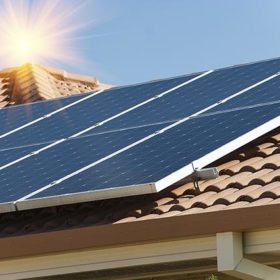Things move quickly in the U.S. solar market. As recently as 2012 Georgia was not really on the map for solar, with the 22nd-largest state market according to GTM Research and Solar Energy Industries Association (SEIA). However in 2016 the state grew to the 3rd-largest solar market, installing more than 1 GW and outpacing states in the Northeast and Southwest which have traditionally led the market.
Yesterday Georgia’s solar ambitions got another boost with Southern Company subsidiary Georgia Power announcing that it has received approval from state regulators to build a 139 MW solar project next to the Robins Air Force Base (AFB) in Georgia, near Macon.
This will be Georgia Power’s sixth utility-scale solar project in collaboration with the U.S. military, and the company’s largest single-site solar project to date. Given more dense settlement patterns and smaller plots of available land, projects larger than 100 MW are usually not built east of the Mississippi River in the United States.
However, Georgia Power was able to take advantage of the presence of a buffer zone between the base and neighboring communities for the project, which will comprise more than half a million PV modules.
Georgia Power plans to set up a competitive bidding process for a construction contractor over the next 18 months, who will begin construction no earlier than 2018. Georgia Power plans to put the plant online by the end of 2019.
The plant at Robins AFB will join 120 MW of operational solar at four U.S. Army and Navy bases, as well as a 31 MW solar project which the company is currently building at a U.S. Marine Corps base.
All told, Georgia Power plans to add up to 1.6 GW of renewable energy through 2021, as outlined in its long-term plan which has been approved by the Georgia Public Service Commission (GPSC).
The story of Southern Company’s, and Georgia’s, transformation from solar laggards to leaders is not atypical for many U.S. utilities. Southern initially resisted any solar in the service area of its utilities, but was forced to begin building large-scale solar by a pro-solar majority on the GPSC.
But after being pushed into solar, the utility – which is also known for its romance with nuclear power – has taken the tack that if solar will be built in its service area, it wants to be the one that builds it, and wants this solar to be utility-scale.
Thus Southern Company can retain its monopoly and its position as the “fourth branch of government” in Georgia, and still appease a pro-solar Conservative movement which has made alliances with Sierra Club and the solar industry.
This content is protected by copyright and may not be reused. If you want to cooperate with us and would like to reuse some of our content, please contact: editors@pv-magazine.com.









By submitting this form you agree to pv magazine using your data for the purposes of publishing your comment.
Your personal data will only be disclosed or otherwise transmitted to third parties for the purposes of spam filtering or if this is necessary for technical maintenance of the website. Any other transfer to third parties will not take place unless this is justified on the basis of applicable data protection regulations or if pv magazine is legally obliged to do so.
You may revoke this consent at any time with effect for the future, in which case your personal data will be deleted immediately. Otherwise, your data will be deleted if pv magazine has processed your request or the purpose of data storage is fulfilled.
Further information on data privacy can be found in our Data Protection Policy.